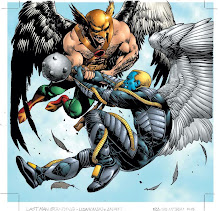We have Alan Scott, the original Green Lantern: Newsarama\'s field guide to Green Lantern (Alan Scott)
Alan Scott, the One, Original Green Lantern: The first Green Lantern found fictional life in the pages of All-American Comics #16, cover-dated July of 1940. The concept began with artist Martin Nodell who, with writer Bill Finger, gave us the character that had its partial roots in the railroad. Proving that inspiration can come from any place at any time, Nodell fused the sight of a subway rail employee waving a green “all clear” lantern with the idea of Aladdin. From that germ came the blueprint for the story of a man with a “magic ring” powered by said lantern that could accomplish feats basically limited by his imagination and willpower and the energy’s weakness in the face of . . . wood.
In terms of comics continuity, Earth-2 dweller Alan Scott’s lantern was composed of a green flame that came to Earth in the distant past. When Scott came into possession of the object, it “told” him how to make his ring from the lantern itself, and the young engineer created the identity of Green Lantern. In the wake of “Crisis on Infinite Earths”, Alan Scott’s story would become more complicated. The original green flame turned out to be The Starheart, mystic energy collected by Oa’s Guardians and hidden in a star, which then attained sentience. This made for a direct connection between Scott and the Corps, even if he himself is not an official member.
Scott can proudly boast membership and founder status with the Justice Society of America. When the security of America and the life of the president were in danger just prior to World War II, GL and a number of other heroes (including the Jay Garrick Flash, the original Hawkman, Dr. Fate, Hourman I, the Atom, and more) saved the day and remained a team at the behest of the president. When World War II began, the JSA became the Justice Battalion and also held simultaneous membership in the larger group of heroes known as the All-Star Squadron.
Thanks to his mystical roots, Scott has been a member of the loosely affiliated Sentinels of Magic, heroes tasked to deal with supernatural threats. He’s also been a part of Checkmate. For a period of time prior to Zero Hour (1994) and on up until 2003, Alan Scott went by the name “Sentinel” partially in deference to the destruction of the GL Corps and the fact that Kyle Rayner operated as the only remaining GL for much of that time. During the “Princes of Darkness” storyline which led to the redemption of Obsidian (more later), Scott took back the GL name.
>
Next is Green Arrow: newsarama\'s guide to Green Arrow
Golden Age/Earth-2: Shipwrecked millionaire Oliver Queen learned to survive by becoming the world’s greatest archer; upon his return to civilization, he battled crime with trick arrows as Green Arrow (More Fun Comics #73, 1941). That was easy! As you know, the Golden Age versions of DC’s icons found themselves relegated to Earth-2 at the advent of the Silver Age. The Golden Age Green Arrow and his sidekick Speedy (Roy Harper) held memberships in the Seven Soldiers of Victory (aka The Law’s Legionnaires) and the All-Star Squadron. During the “Crisis on Infinite Earths”, the Earth-2 Green Arrow was killed fighting the Anti-Monitor’s shadow demons. When the history of the new Earth was shown later, Green Arrow and Speedy had been retconned out of the Soldiers and the Squadron, replaced by, depending on the retcon, by some combination of Alias the Spider, Crimson Avenger’s sidekick Wing, or Vigilante’s sidekick Stuff. Weirdly enough, yet another retcon line-up was introduced in DC Legacies #2, this one including TNT and Dan the Dyna-Mite.
”Our” Ollie: The updated Green Arrow had essentially the same origin as his counterpart, though other tweaks and details have sunk in over time. Originally clean-shaven and wearing the green and red, Ollie popped the Vandyke and adopted his classic look in 1969. This Green Arrow was the first post-founding member of the Justice League of America (though JLA Year One, which probably isn’t even in continuity anymore, suggests that Queen secretly financed the young team from the beginning).
